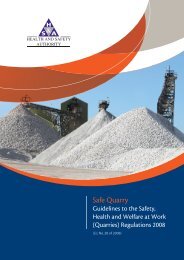Guide to the Safety, Health and Welfare at Work (General Application)
Guide to the Safety, Health and Welfare at Work (General Application)
Guide to the Safety, Health and Welfare at Work (General Application)
Create successful ePaper yourself
Turn your PDF publications into a flip-book with our unique Google optimized e-Paper software.
Regul<strong>at</strong>ions 2007<br />
Sliding doors should have effective means <strong>to</strong> prevent <strong>the</strong>m from coming off <strong>the</strong>ir<br />
tracks. They should have a retaining rail <strong>to</strong> prevent <strong>the</strong>m falling should <strong>the</strong>ir<br />
suspension system fail or <strong>the</strong> rollers leave <strong>the</strong> track.<br />
(f) doors <strong>and</strong> g<strong>at</strong>es opening upwards are fitted with a mechanism <strong>to</strong><br />
secure <strong>the</strong>m against falling back,<br />
<strong>Work</strong>place<br />
Upward opening doors should be fitted with an effective device, such as a counter<br />
balance or r<strong>at</strong>chet mechanism, <strong>to</strong> prevent <strong>the</strong>m falling back in a manner likely <strong>to</strong><br />
cause injury.<br />
(g) <strong>the</strong>re are doors or g<strong>at</strong>es for pedestrian traffic in <strong>the</strong> immedi<strong>at</strong>e<br />
vicinity of g<strong>at</strong>es intended primarily for vehicle traffic, unless it is safe<br />
for pedestrians <strong>to</strong> pass through, <strong>and</strong> such doors or g<strong>at</strong>es are clearly<br />
marked <strong>and</strong> kept unobstructed <strong>at</strong> all times, <strong>and</strong><br />
Where <strong>the</strong> speed <strong>and</strong>/or volume of traffic cre<strong>at</strong>es a risk <strong>to</strong> <strong>the</strong> safety of persons,<br />
separ<strong>at</strong>e pedestrian <strong>and</strong> vehicular routes should be provided <strong>at</strong> any entrance or exit<br />
point in a workplace. Account should be taken of <strong>the</strong> gre<strong>at</strong>est volume of traffic, <strong>the</strong><br />
number of persons likely <strong>to</strong> use <strong>the</strong> route <strong>at</strong> any given time, <strong>the</strong> width of <strong>the</strong><br />
g<strong>at</strong>eway <strong>and</strong> <strong>the</strong> degree of visibility from both sides.<br />
Some form of traffic control may be necessary <strong>to</strong> secure pedestrian safety.<br />
The boundaries of pedestrian <strong>and</strong> vehicular routes should be clearly defined, for<br />
example by <strong>the</strong> use of raised footp<strong>at</strong>hs or kerbs.<br />
In respect of frequently used doorways fitted with plastic curtains, unless <strong>the</strong><br />
doorway is wide enough <strong>to</strong> facilit<strong>at</strong>e <strong>the</strong> safe passage of both pedestrians <strong>and</strong><br />
vehicles on clearly marked routes, altern<strong>at</strong>ive access arrangements for pedestrians<br />
should be provided. Plastic curtains become opaque over time from wear <strong>and</strong> tear.<br />
Regul<strong>at</strong>ion 14 also addresses pedestrian safety.<br />
(h) mechanical doors <strong>and</strong> g<strong>at</strong>es—<br />
(i) function in such a way th<strong>at</strong> <strong>the</strong>re is no risk of accident<br />
<strong>to</strong> employees,<br />
(ii) are fitted with easily identifiable <strong>and</strong> accessible emergency<br />
shut-down devices, <strong>and</strong><br />
(iii) can be opened manually where <strong>the</strong>y oper<strong>at</strong>e as an emergency<br />
exit, unless <strong>the</strong>y open au<strong>to</strong>m<strong>at</strong>ically in <strong>the</strong> event of a<br />
power failure.<br />
Power-oper<strong>at</strong>ed doors <strong>and</strong> g<strong>at</strong>es should be designed, installed <strong>and</strong> maintained <strong>to</strong><br />
prevent injury as a result of being struck by <strong>the</strong> door or g<strong>at</strong>e or being trapped<br />
between parts of it or between it <strong>and</strong> a wall or floor. Some examples of safety<br />
devices for controlling mechanical doors <strong>and</strong> g<strong>at</strong>es are:<br />
17

















